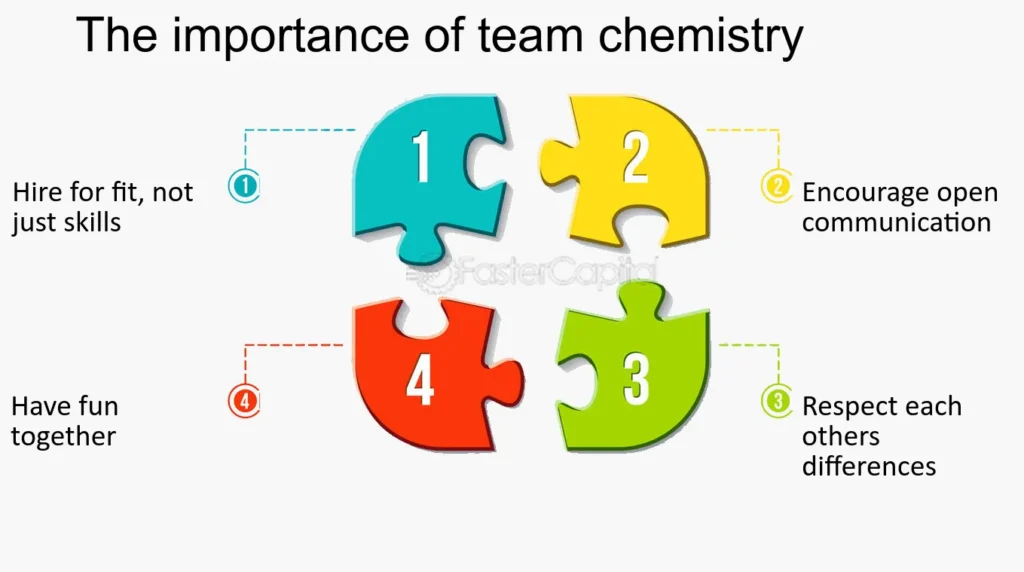Football is one of the games where brilliant moments can easily change the fortunes of a game through team chemistry .This is often why people think that football success lies with talented players. History, however, tells a different story: it’s not just filled with star players, but something that truly connects all members together—team chemistry. While skills, tactics, and physical fitness are important factors, it is the invisible glue that holds the players together, which often proves to be the difference between winning and losing. Let’s delve into why team chemistry is so crucial for football and how it affects a team’s ability to play at its best.
1. The Base of Trust and Communication
Football, among other sports, requires constant communication and mutual trust between its players. Players have to share the understanding of the game along with each other’s movements-quick pass, off-the-ball run, defensive shift, whatever it may be. This type of trust, however, isn’t something gained overnight; instead, it grows from shared experience, time, and understanding other players’ tendencies.
Good team chemistry makes the game more smooth and intuitive for communication on the field. For example, a center-back trusts that a full-back will cover their position if they are to push forward or a striker knows where a midfielder is going to place a pass. All this seamless interaction stems directly from chemistry as players get used to predicting one another’s moves without the need to verbalize every action.
In the absence of strong chemistry, even the best players can look disjointed or disconnected. Miscommunications cost mistakes, misplaced passes, and missed opportunities-all things that can undermine the confidence and performance of the team.
2. Shared Goals and Collective Mindset
At the base of any well-functioning football squad is a team vision. Whatever personal goals every player may desire to achieve while playing, perhaps scoring goals and winning awards; the ultimate is winning as one unit. Chemistries and the team goal align these objectives with the general purpose: successful achievement as an entity.
More selfless players will work for the team when they realize and understand the group goals because such behavior contributes to the fulfillment of the collective goals. Evidence of this selflessness is seen with passing without selfishness, covering teammates, or even using themselves as a hostage to achieve a position desirable for team strategy. Football is really a team game, and individual brilliance can only take a team so far.
For instance, a forward with an opportunity to shoot passes to a teammate who is in an even better position. This move is not for individual sacrifice; it is just trusting the entire team and believing that winning occurs when everyone performs their role in the game. Teams that exhibit great chemistry are generally those that perform as a whole, where players know their function in the context of achieving the same goal.

3. Team Coherence in Tension
Football is a highly tensioned game. Be it the last minute of a very close game, penalty shootouts, or a match played on an away field with an adversarial crowd; the composure to keep up with stressful moments is vital. This is where team chemistry is at its prime.
When tensions are running high, the members of a tight-knit team help each other mentally and emotionally. They uplift each other’s moods, calm down nerves, and focus on the task at hand. Players who have good bonds are less likely to break under pressure because they trust in their teammates to perform their roles and provide support when needed. A team that has developed a deep sense of unity is far more resilient in the face of adversity, whether it’s an early goal conceded or a referee’s controversial decision.
For instance, a team could be losing game in the end. If good chemistry is intact among the members, they do not lose each other’s believes and keep acting together. By contrast, for a team short of chemistry could easily break to pieces as most of the member try to do lots of things personally, thus failing or missing everything.
4. Good Environment And Inspiration
A team’s chemistry extends beyond what happens on the pitch; it’s also about how players interact off the field. A positive and supportive atmosphere within the locker room fosters trust, camaraderie, and mutual respect, all of which contribute to a motivated, driven team.

In places where players love the company of the other players and all respect each other, the general morale is generally positive. These become inputs on the field where the players will most likely work for one another and celebrate each other’s victories. Team chemistry is the little things: an encouraging word when a player is down, the celebratory high-five after a great play, or just the shared laughter that keeps morale high.
When morale is high, the motivation to play your best will always be higher. A team that has positive chemistry is more resilient in times of adversity and instead of pointing fingers or laying blame, will pick each other up. Such a collective support system can make a difference in terms of getting back on track during setbacks, and often, it is what enables a team to maintain its performance throughout a long and grueling season.
5. Consistency and Long-Term Success
In football, consistency is the key. A team that does well one week and then does poorly the next hardly ever achieves long-term success. Consistency comes from stability, and that’s where strong team chemistry shines. Teams with great chemistry are better equipped to maintain their performance over time because they know each other’s habits, movements, and reactions.
This is evident in successful teams with a long history, such as FC Barcelona, Bayern Munich, or Manchester City, who have kept a high level of performance for many seasons. Their success isn’t just because of their tactical setup or the individual players but because of the deep connections that exist between them, built over time. It allows them to play together with an understanding and fluidity that makes them hard to beat at any given time.
6. The Role of Leadership in Chemistry
Leadership is a critical component of team chemistry. A team’s leaders, be it captains or influential players, set the tone and help establish the environment within which chemistry can thrive. These leaders inspire others to work together toward a common goal and foster open communication among all members. A good leader instills an environment of trust, respect, and accountability, which makes players feel comfortable to say what they have to say and play without the fear of failing.
The best leaders know that leadership is all about serving the team and not commanding them. They understand when to motivate, when to stand up for them in difficult times, and how to keep everyone harmonious as a group. A leader with strong chemistry with teammates will bring a place of collaboration, mutual respect, and collective effort toward the success that should be accomplished.
Conclusion
Team chemistry is the secret sauce that turns a group of talented individuals into a successful, cohesive unit. Built on trust, communication, and shared goals, it can make all the difference between winning and losing. Teams that have great chemistry play with fluidity, resilience, and an unshakable belief in each other no matter what’s happening. With the sport of football growing and getting tougher, individual brilliance is not enough. Success in teams can be seen as those that form deep, supporting relationships, not only on but also off the pitch. Therefore, while the headlines are of goals, assists, and saves, it is the deep connection between players that truly determines the success of a team in the long run.






